With spring feeling more like winter and despite the fact that it is the close season and Easter is looming large I’ve been thinking back to the warmer times of last summer when I focussed on barbel fishing on my local Derbyshire Derwent and was treated to some excellent fishing. Unfortunately my winter fishing was almost non-existent and largely fruitless, but my early season barbel sport last season was definitely worth writing about – so here we go!
I have done a lot to refine my summer barbel tactics over the past four seasons and this has resulted in me successively improving on my personal best in each of these seasons, so I consider my current approach to be very effective. This summer proved to be my most successful yet with various double figure fish landed and a large number of 8 and 9lb fish to back them up. This success could well be down to concentrating my now very limited fishing time to a couple of stretches of a single river; usually I fish for barbel on the Trent and Dove besides the Derwent but, as much as I love all three rivers, in spreading my time between them I never fully come to terms with where the fish are on all of them and results can be patchy.
The Trent is the most reliable in terms of what river conditions to expect (the Dove, a true spate river, certainly the least reliable), but the Derwent is smaller and therefore easier to work out during after-work evening sessions of three to four hours that form 95% of my fishing between May and November.
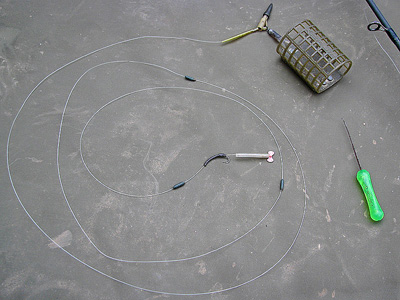 My tactics revolve around a basic rig which starts with a strong, micro-barbed hook attached to what I believe is the key feature – a long clear monofilament hooklength of at least five feet (Ultima Powersteel has been very reliable) and I use a mixture of rig putty and Korda Sinkers to pin this down.
My tactics revolve around a basic rig which starts with a strong, micro-barbed hook attached to what I believe is the key feature – a long clear monofilament hooklength of at least five feet (Ultima Powersteel has been very reliable) and I use a mixture of rig putty and Korda Sinkers to pin this down.
A quick-change swivel allows me to switch hooklengths quickly and these are secured by a stiff rig boom off the swivel which helps prevent tangles around my feeder. The feeder is attached to the rig with a safety lead-clip and I use large capacity feeders such as the Korum ones, which are available in various weight loadings between 2oz and 5oz. That’s it for the rig; I did for a while use flying backleads, but my results have actually improved since I did away with them and instead use longer hooklengths; the rig is much easier to cast without a backlead, too.
In the past I used leads rather than feeders and introduced loosefeed with PVA bags or stockings but with a high quality groundbait carrier, a swimfeeder is by far the simplest and most practical way of introducing a controlled amount of freebies close to your hook bait. The large capacity of the aforementioned feeders allows me to put in a good-sized groundbait plug then stuff in some mixed pellets, hemp and casters before plugging again with groundbait. Having a thick enough plug in each end of the feeder is important because it ensures the cargo of pellets reaches the riverbed before it is deposited. If the water is coloured I will squirt in a liquid bait additive, such as the Source or Savoury Spice, all over the pellets before capping them off, so as soon as the groundbait breaks away a potent burst of flavour dissipates downstream to hopefully set the senses tingling of any barbel in the area.
During the summer I varied my groundbait mixes to suit the temperature and water clarity, but the core ingredients revolved around fishmeal, hemp, krill and spicy meat. This is mainly because I know that barbel are attracted to a wide range of baits and giving them as wide a taste spectrum as possible to home-in on makes sense, as I’ll elude to further when I discuss hookbaits.
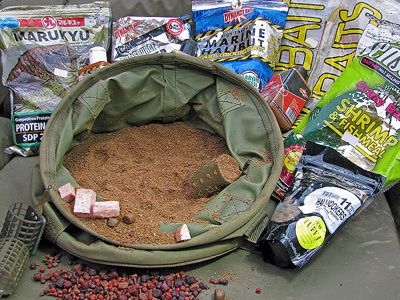 My theory is that the barbel will recognise the overall aroma as attractive but will only be familiar with certain elements of it. Also, in different conditions and with different individual fish, some flavours will appeal more than others, so I think that introducing such a range of flavours and scents into the swim sets my baits apart from anglers who use a more basic mix. It also ensures that if one flavour, such as halibut pellet, has been used extensively by others the fish approach my baits with a lesser degree of wariness.
My theory is that the barbel will recognise the overall aroma as attractive but will only be familiar with certain elements of it. Also, in different conditions and with different individual fish, some flavours will appeal more than others, so I think that introducing such a range of flavours and scents into the swim sets my baits apart from anglers who use a more basic mix. It also ensures that if one flavour, such as halibut pellet, has been used extensively by others the fish approach my baits with a lesser degree of wariness.
Two groundbaits that have entered my mix this season are ‘SFA 400 Krill’ by Marukyu and ‘Spicy Meaty Method Mix’ by Sonubaits. The loosefeed pellets that I use are also of a mixture of flavours and sizes; some smaller and lighter ones will drift downstream and hopefully draw fish up and the different flavours ensure that something will appeal to most individual fish and once they have confidence hovering up freebies barbel tend to get less picky.
When it comes to hookbaits I’ve also found that mixing flavours of boilies or pellets is a good thing for barbel, yet I hardly see anyone writing about this. Early on in the season when the fish have had a lay-off from introduced feed, I might use a single, smaller hookbait, but after a few weeks I step up to a double bait and more often than not it’s the cocktail baits that outscore those of matching flavours. For instance, I might fish a krill boilie on the same hooklength as a Source one, or maybe a halibut pellet alongside a spicy sausage pellet.
It’s worth experimenting with baits, which is how I ended up using cocktail hookbaits in the first place and I’ve seen my results improve ever since. Often a switch mid-session from a pair of matched hookbaits to mixed ones has resulted in a fish almost immediately! However, one of the most consistent barbel catchers in all seasons continues to be luncheon meat and I always have a tin in my bag, but from September onwards it’s usually my ‘go-to’ bait.
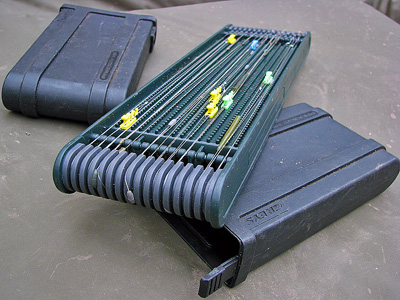 In its most basic form luncheon meat oozes with oils, fats and salt and thus remains attractive to all manner of species. Despite the success of the ‘standard’ bait, there are a few things that can be done to further improve its attraction though.
In its most basic form luncheon meat oozes with oils, fats and salt and thus remains attractive to all manner of species. Despite the success of the ‘standard’ bait, there are a few things that can be done to further improve its attraction though.
When the rivers are warm, simply soaking cubes of meat overnight in fish oil or liquid flavouring can work wonders and on even on the bank oil can be injected into the meat with a syringe, much as you‘d do with a deadbait for pike, but if you plan ahead a little you can get a bit more creative.
Setting up your fishing stove and a cheap frying pan in the garage can give you free reign to get the stinky stuff out and by this I mean anything from halibut oil (good for frying bait with) to fish sauce, liquid stock, spices and whatever else you can lay your hands on. Pile everything into a bag with cubes of meat, give it a good shake and fry each side of the cubes until they firm up, which will help them stay on the hook or hair better, then bang it in the freezer for future use.
You don’t even need to fry the meat; I caught a couple of double figure barbel in the summer on some luncheon meat I had prepared with a little bit of oil, garlic powder, krill powder, curry powder and a little meaty groundbait, all shaken in a bag and left to mature for a day before freezing. The freezing and thawing process itself will draw the flavours deeper into the meat. You’ll notice that when flavouring luncheon meat I still favour a mixture of aromas, but even adding one of the above will give your baits a little boost and is well worth an experiment.
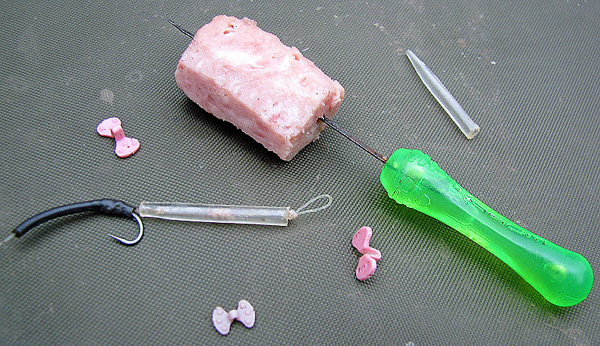
If you’ve ever hair-rigged luncheon meat before you’ll know it’s a common occurrence for the hair to slice through the bait like a cheese wire. I like to be confident that I have a baited hook and for years I’ve used the Fox luncheon meat stops. These are made up of a silicone sleeve that slides over the hair before the bait to increase the surface area of the hair to stop it slicing, and a large, flat-faced hair stop that again has a large surface area which doesn’t pull through the meat as easily as a boilie stop. Used together they do a brilliant job in keeping the bait on the hair and I highly recommend them.
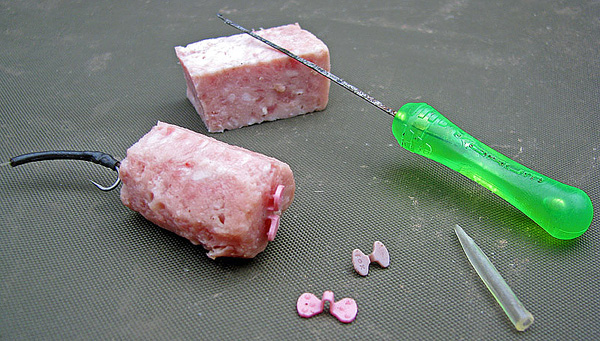
When choosing barbel swims in summer I have three types of swim that I will look for on a new stretch of river and between them they give me a variety of options to help minimise blanks, no matter what state I find the river in. If you can find a swim or run that combines more than one of the key elements then you should really be onto a winner.
With summer floods seemingly becoming more frequent an essential swim to find is one featuring a deep slack, ideally in the near margin. This type of swim gives two advantages: the first being a guaranteed crease, which is a bankable feature to find feeding barbel in at any time of the year. The second advantage is that a slack in the near margin will allow you to fish, even when the river is in such a flooded rage that it’s infuriatingly impossible to fish elsewhere, when even if you have enough lead to hold bottom, the line seemingly catches every piece of detritus in the river! If you arrive at a river and find conditions like these, it’s easy to become disheartened but it’s well known that barbel feed well during floods so having a reliable slack swim will at least allow you to keep a bait in the water, and while ever this is the case, you’re in with a chance.
Barbel love to feed over gravel, so try to find a deep swim with a gravel substrate, rather than a silty one; such swims can often be found on the outside of bends, which can give the added bonus of an undercut bank – perfect shelter for barbel – and if layers of gravel are visible on the eroded edge of the bank then this is a good sign that there is gravel below.
On one session in mid July, I was reminded of the need to focus until the last bait is removed from the water. I had been fishing in one swim for a couple of hours without as much as a tremble on my rod tip, I toyed with the idea of moving several times, but we’d had some heavy rain and I had a feeling that one of my favourite deep swims would produce a barbel or two, so I stuck with it.
It’s important to remember that a session isn’t over while you’re still fishing and sometimes what can seem like a dead-cert blank can turn into a good session in a few frantic minutes. If, for whatever reason, you have fish in the swim which only decide to show themselves during a brief spell, your luck can change in an instant when they do come on the feed. The worst thing is the not knowing whether to ‘stick or twist’, but using tactics you have faith in and a methodical approach to locating fish cannot be overemphasised for giving you the confidence to make the right choice and avoid a blank.
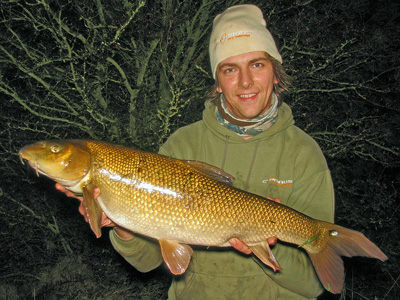 Eventually my faith was justified when a 6lb barbel made an appearance late on in the session. It was almost midnight and I was only planning on fishing for another few minutes but no sooner had I sat down after returning the fish than the same rod tore off again and I connected with my second barbel in a matter of minutes. The fish felt large and down in the deep, slack water beneath my feet, previous floods had deposited some sunken debris – probably a large chunk of a tree – and the high water was making landing this fish difficult. I usually try to land all of my fish without turning on my headlamp, but given that this would be my last cast and that I’d be packing up as soon as I‘d released the fish, I broke my own golden rule and shone my headlamp into the water.
Eventually my faith was justified when a 6lb barbel made an appearance late on in the session. It was almost midnight and I was only planning on fishing for another few minutes but no sooner had I sat down after returning the fish than the same rod tore off again and I connected with my second barbel in a matter of minutes. The fish felt large and down in the deep, slack water beneath my feet, previous floods had deposited some sunken debris – probably a large chunk of a tree – and the high water was making landing this fish difficult. I usually try to land all of my fish without turning on my headlamp, but given that this would be my last cast and that I’d be packing up as soon as I‘d released the fish, I broke my own golden rule and shone my headlamp into the water.
This did the trick and I soon slid a mint 9lb 9oz fish over the net rim. I quickly weighed and photographed the fish and was standing in the river nursing it back to strength when the alarm on my other rod broke the silence. This rig was only dropped in the edge, right under the rod tip and just feet away from where I’d just been shining my headlamp, landing the fish! To have a run on this rod was a complete shock as I had written off my chances of any further fish. Thankfully the barbel I was holding had started to kick its tail convincingly, so I let it go and grabbed the other rod. I connected with another heavy fish that I managed to fluke into the net before it really knew it was hooked! My second 9lb plus fish in less than ten minutes came to the bank to complete a memorable hat-trick.
Thankfully I’d had faith in what I was doing and my decision to stick paid off. I resisted the temptation of another cast but was still very late getting home. The memories of the night before helped me work through the tiredness at work the next day though!
The next key swim type for summer barbel is a fast, shallow swim which comes into its own during ‘normal’ summer river conditions, where the river is low and clear. This is important because such water is usually interspersed with shallow areas of broken water, which puts in oxygen and thus draws in fish. Gravel areas below weirpools are an exaggerated version of this and their reliability as barbel holding – and indeed fish holding – swims has been widely discussed for decades and these places can never be overlooked.
Ideally I look for a depth of 3-5ft above a gravel bottom with healthy beds of streamer weed. If there are any slightly deeper depressions in the riverbed, where food could accumulate, then these are the areas I concentrate on. If the run is pretty uniform then I’ll try to pick a spot with a bit of a clearing between the streamer weed. Not only does this give me a spot I can to cast to with confidence when it gets dark, but it is also an indication of a place where barbel have fed and uprooted the weed.
Such a swim gave me a few memorable sessions last year but one evening in particular turned out to be rather special for me. I had been listening to Usain Bolt storming to Gold in the 200m final on 5 Live earlier in the evening, so it was already quite an exciting night but the fish were taking their time coming on the feed. Shortly after the final my friend Craig landed the first barbel of the night, which assured me that I should be due some action too.
I had to wait until 10 o’ clock before I had a really gentle take on one of my cocktail hookbaits but the fish was no sooner hooked than it locked me up solid by going straight through a bed of streamer weed. I feared the battle was lost at first, but gradually I worked the fish out and into open water. It was one of the strangest fights I’ve ever had because the swim was very pacey and, despite bringing the fish to the surface, I could do nothing with it!
My tackle strained as the fish seemed to just hold its position, barely flexing a fin, but giving the impression that I was connected to a solid, immovable object. It was reminiscent of the latter stages of my fight with a mahseer, when I was willing the fish to come in whilst it nonchalantly floundered midstream, as if taunting me with its power. After a couple of failed attempts at netting the fish where I was, as the force of the flow on the net was too much for my left arm, I conceded that this fish was worth upsetting my margin swim for (where my other rod was cast so I moved downstream slightly to where the flow was less intense and netted the fish first time.
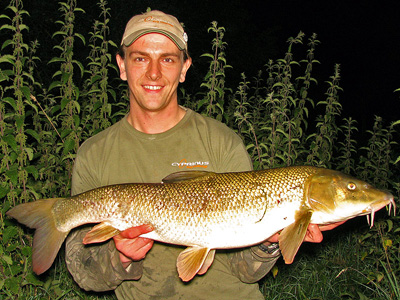 I knew it was a double, but it was only when I went to lift the net from the water that I realised it was a new PB – I had never felt a barbel like this before! I weighed it three times, zeroing the scales each time, to make sure I wasn’t fooling myself because the scales were reading well over 14lb. Each time they read the same though and with the net taken off, the fish weighed 13lb 1oz, which for the Derwent is one of a few proper heavyweights. I was beside myself; only three seasons prior had I finally broken the 10lb mark after many years of trying; since then doubles have come fairly frequently but this fish added almost 2lb to my PB.
I knew it was a double, but it was only when I went to lift the net from the water that I realised it was a new PB – I had never felt a barbel like this before! I weighed it three times, zeroing the scales each time, to make sure I wasn’t fooling myself because the scales were reading well over 14lb. Each time they read the same though and with the net taken off, the fish weighed 13lb 1oz, which for the Derwent is one of a few proper heavyweights. I was beside myself; only three seasons prior had I finally broken the 10lb mark after many years of trying; since then doubles have come fairly frequently but this fish added almost 2lb to my PB.
I went on to land a fish of just under 9lb and then had a double hook-up and managed to land both – although these were much smaller samples of around 4lb each, like peas in a pod. That night it seemed like I could do no wrong; on another night I might have lost the first fish in the weedbed without ever realising its size or significance, so I’m still savouring that evening all these months on.
With the conditions I faced this summer I didn’t have to resort to my third and final swim type, but it is worth a mention because it’s got me ‘out of jail’ plenty of times in the past and this is the snag swim.
In rivers all but the largest snags can be temporary things, deposited by one flood and then moved on again with the next. Most snags you’ll encounter are fallen trees, branches or roots and, as with most species, barbel will utilise the shelter they offer and the steady supply of food that drops to the riverbed in the slack water immediately downstream of them.
Marginal snags such as tree roots are often more permanent and if you can find one with the right surrounding habitat they can hold fish in most conditions, so they make perfect banker swims to drop a bait into whenever a blank is on the cards elsewhere. However, if you can find a large snag deposited midstream on a gravel run, it’s worth taking advantage of it during the summer because you can be confident that the barbel will be.
There are three ways of approaching a midstream snag and each have their potential pitfalls. Firstly, casting immediately upstream of the snag is tempting because it gives a great chance of getting a quick take, but carries a massive risk of a fish becoming snagged once hooked and even tackle which you think is strong is no match for a tree trunk and there’s a high chance of leaving fish snared to the snag, which I find unacceptable, so that leaves the other two options: casting from downstream towards the snag or casting a few metres above the snag.
The former is certainly the safest bet in terms of landing a hooked fish, but barbel will congregate below the snag, so casting directly into their sanctuary is a sure fire way of spooking your quarry, although in some swims the only casting access to the snag may be from downstream so it may be your only choice.
The final option is the best all-round one, but it can take a little patience to reap the benefits of the snag. The best technique is to trickle bait in upstream of the snag over a period of time to gain the confidence of the barbel and get them moving away from their refuge into the more open water. As darkness approaches you are in with a greater chance but even in the middle of the day once barbel get the taste and the confidence their desire to feed can outweigh their instinct to seek shelter and you‘re in with a good chance.
All in all I had a terrific summer of barbel fishing, which was as enjoyable as it was productive. If you’re new to barbel fishing then hopefully some of the above will give you some confidence to give it a try. There’s nothing too difficult about catching barbel once you’ve got the basics right and if you already love catching barbel then maybe something in this piece will spur you on to get the barbel rods out if we get some mild, wet weather before the end of the season.










